23 August 2024.

Today, there are a lot of new developments in the Kursk direction.
After the confirmed destruction of three bridges over the Seym River, as analyzed in our previous report, several military analysts anticipate that Ukrainian forces will now shift their focus to the western flank of the incursion. In the coming days and weeks, their efforts are likely to concentrate on tightening control over the newly formed cauldron, where a significant number of Russian soldiers could find themselves encircled and cut off from retreat.
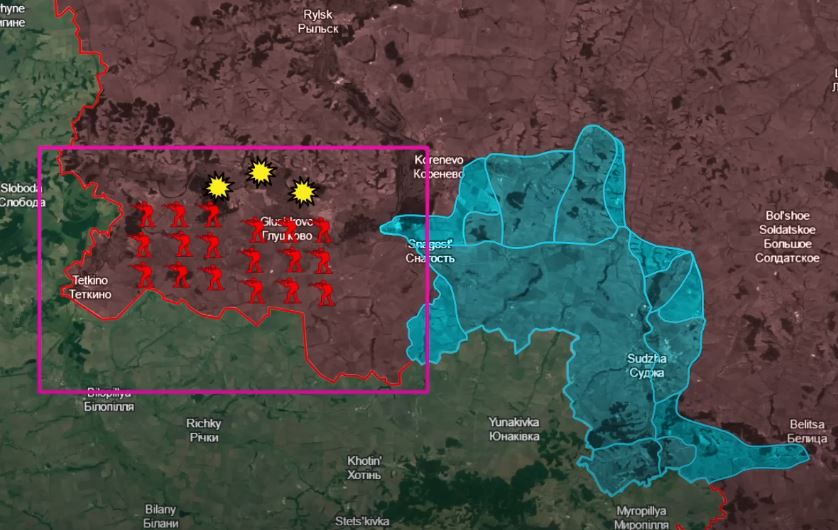
This strategy aims to capitalize on the current momentum, potentially leading to further entrapment and surrender of Russian forces.
Ukrainian President Volodymyr Zelenskyy recently announced that Ukrainian forces have successfully expanded their zone of control in Kursk, deepening it from 28 to 35 kilometers and now covering approximately 1,250 square kilometers, including 92 settlements. The potential capture of a bridgehead, bordered to the north by the Seym River, could further extend this area by additional 700 square kilometers, significantly bolstering the territory under Ukrainian control.
Ukraine cut off almost entire Glushkovo district in Kursk, Russians say
In recent days, military analysts have explored the strategic reasoning behind the staggered destruction of the three bridges over the Seym River. Instead of attacking all the bridges simultaneously, Ukrainian forces chose to destroy them over several days, when the first option would have increased the number of Russian forces cut off from their supply lines on the left bank of the river, creating an operational encirclement.
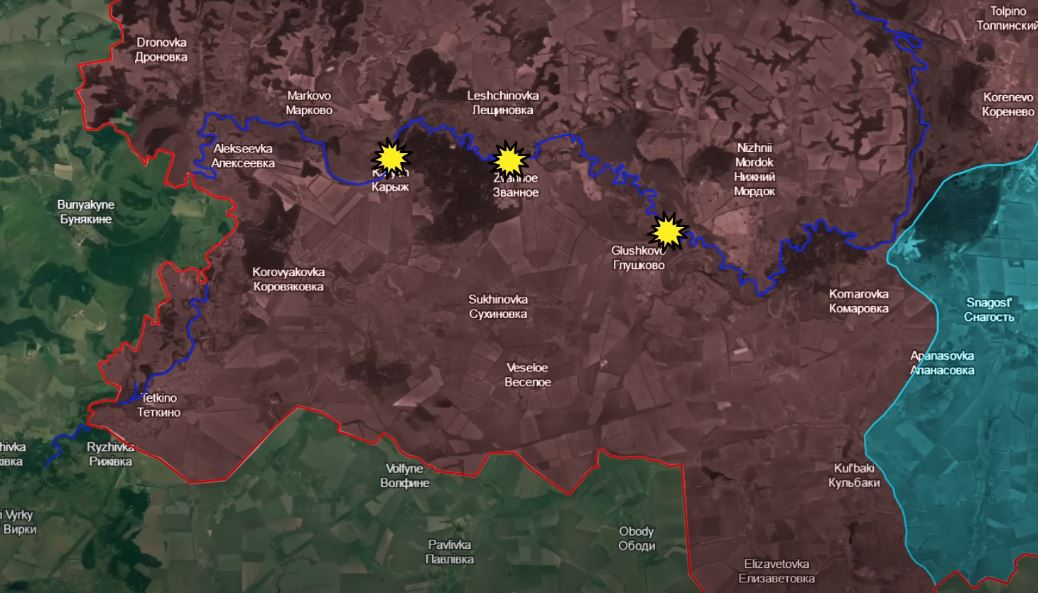
Analysts conclude that this approach was likely intended to offer Russian troops a window to withdraw, thereby minimizing unnecessary Ukrainian losses in battles for these territories. By doing so, Ukrainian forces presented the Russian command with a difficult choice: either maintain their positions under increasingly untenable conditions, risking encirclement, or withdraw as many troops as possible before the situation deteriorates further.
With all three bridges now destroyed, isolating the cauldron has become a top priority for Ukrainian forces. Some Russian analysts have suggested that Russian troops might attempt to address the logistical challenges by deploying pontoon bridges, small barges, or inflatable boats. However, this area is already under close Ukrainian surveillance. The first Russian pontoon bridges, set up approximately three kilometers north of Glushkovo, were swiftly destroyed by Ukrainian forces. This was confirmed by satellite imagery and NASA FIRMS data, which detects thermal anomalies on the ground in real-time, typically used for forest fire monitoring. Geolocated images of FPV drone attacks later surfaced, corroborating these strikes on the pontoon bridges and military engineering units.
https://twitter.com/EuromaidanPress/status/1825826871491055882/
These developments indicate that the pontoon bridge solution is unlikely to be a viable option for large-scale logistics, further complicating the situation for Russian forces.
https://twitter.com/EuromaidanPress/status/1826201943221637124/
The original, uncensored combat footage of all Ukrainian attacks can be found on Reporting From Ukraine’s Telegram channel.
Analyzing the northeastern section of the 700-square-kilometer area targeted by Ukrainian forces, it’s clear they are intensifying efforts to secure control over Korenevo and its surrounding areas to the west and southwest, extending up to the Seym River. This strategy aligns with the goal of establishing the river as the natural boundary for the territory under Ukrainian control.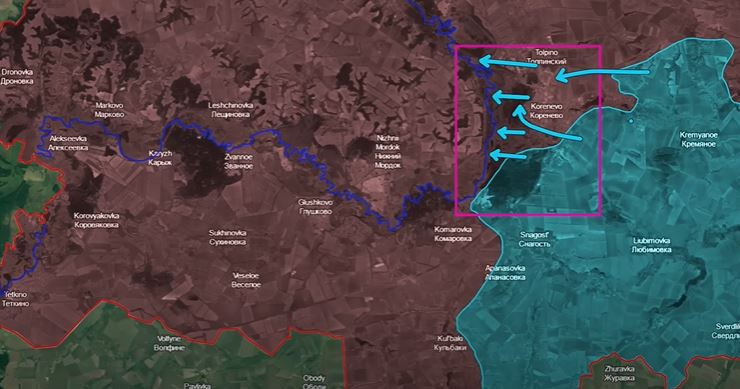
This area offers clear strategic advantages for Ukrainian forces, allowing them to launch attacks from multiple vectors while maintaining extensive fire control from within Ukrainian territory. Securing this bridgehead with minimal battle attrition would mark a significant achievement. However, pushing further north beyond the Seym River appears less practical. If we look at the topographic map we can see prominent elevated areas just north of the river, making them difficult for Ukrainian forces to capture and hold.

Therefore, it makes strategic sense for Ukrainian forces to establish the Seym River as the natural boundary of their controlled territory. In contrast, advancing into this area from Ukrainian territory allows them to move from higher ground, providing them with a significant tactical advantage.
Recent developments in the Tiotkino sector suggest that Ukrainian forces are initiating
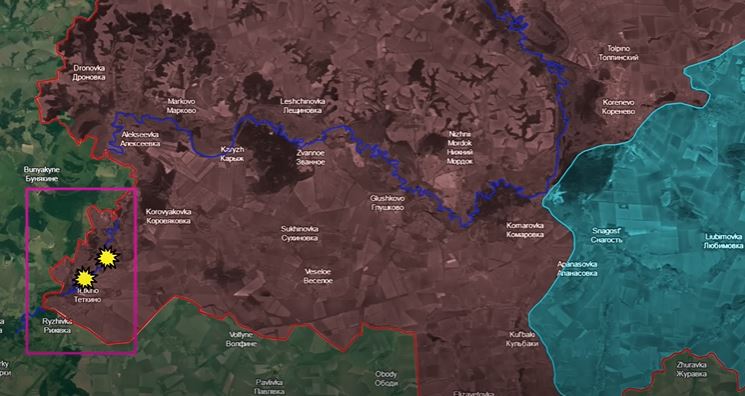
a multi-vector approach to advance on the cauldron. While Russian military analysts previously reported the destruction of several bridges across the Seym River in Tetkino and Popovo-Lezhachi to hinder Ukrainian advances from the international border, they have also confirmed that Ukrainian forces have consolidated their positions in Otruba and along the west bank of the river. Recent geolocated footage shows a MiG-29 fighter jet delivering precision strikes with two JDAM-ER guided air bombs, reducing a Russian border post in Tiotkino village to rubble.

Additional geolocated images reveal further JDAM-ER strikes on Russian positions within Tiotkino. The use of both American and French glide bombs, observed in recent days, underscores the meticulous planning behind the Ukrainian offensive in Kursk. This operation was likely prepared in complete secrecy over several months, possibly even without the full knowledge of Western partners.
Overall, the recent sequential destruction of the three bridges over the Seym River highlights a strategic decision by the Ukrainian command to maximize territorial gains while minimizing casualties. By isolating this entire area logistically, Ukrainian forces are setting the stage for concentrated efforts in the coming days and weeks to secure control over it. The Russians, facing significant challenges in maintaining supply lines to their trapped troops, will find it increasingly difficult to sustain their positions.
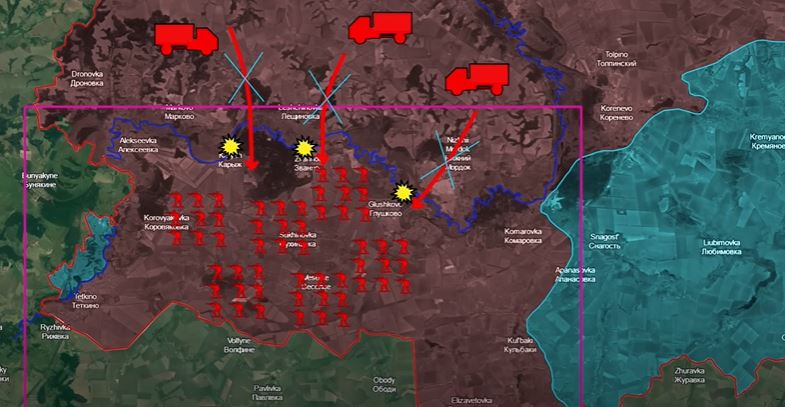
This approach suggests that the Ukrainian High Command is effectively achieving the primary objectives of the operation: creating a buffer zone to protect the Sumy region by preemptively securing the most likely route for a Russian attack, and simultaneously capturing a substantial portion of Russian territory. This captured territory could serve as a valuable asset in future negotiations.
In our daily frontline report, we pair up with the military blogger Reporting from Ukraine to keep you informed about what is happening on the battlefield in the Russo-Ukrainian war.

